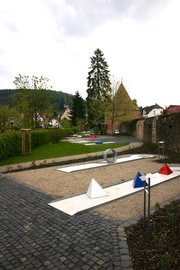Miniature golf

Miniature golf, also known as mini-golf, midget golf, or crazy golf is a game modelled after the sport of golf. The term Putt-Putt is a registered trademark of a miniature golf company, but is commonly used to describe the sport in general. As in golf, courses are commonly nine or eighteen holes long and the object is to hit the golf ball into the appropriate hole in the fewest number of strokes; however, in the miniature game, the holes are significantly shorter and consist of only a putting surface. The game is made challenging by an arrangement of obstacles, ramps and bunkers. It is a popular pastime in many areas of the world, especially among families.
Miniature golf rose to popularity in the late 1910s and early 1920s as a way for early golf fanatics to replicate major golf courses on a small scale. The game was commonly called "Garden Golf" and was played with a putter on grass. Thomas McCulloch Fairbairn, a golf fanatic, revolutionized the game in 1922 with his formulation of a suitable artificial green—a mixture of cottonseed hulls, sand, oil and dye. With this discovery, miniature golf became accessible everywhere, and by the late 1920s there were over 150 rooftop courses in New York City alone.
There are a variety of courses, five of which are officially recognised: the most common of these are beton and eternit.
In 1938 Joe and Bob Taylor from Binghamton N.Y. started building and operating their own miniature golf courses. These courses differed from the ones in the late 20's and early 30's, they were no longer just rolls, banks and curves with and occasional pipe thrown in for the ball to go through their courses had obstacles such as windmills, castles , wishing wells and were landscaped. Impressed by the quality of their courses many customers asked if they would build a course for them. By the early 1940's Joe and Bob formed Taylor Brothers and were in the business of building miniature golf courses and supplying obstacles to the industry. During both the Korean and Vietnam Wars many a G.I. played on a Taylor Brothers prefabricated course the U.S. Military had contracted to be built and shipped over seas. By the late 50's most if not all supply catalogs carried Taylor Brother’s obstacles. In 1961 Bob Taylor , Don Clayton of Putt-Putt, and Frank Abramoff of Arnold Palmer Miniature Golf, organized the first miniature golf association known as NAPCOMS – National Association of Putting Course Operators, Manufacturers and Suppliers, their first meeting was held in New York City. Though this organization only lasted a few years it was the first attempt to bring miniature golf operators together to promote miniature golf.
In 1955, Lomma Enterprises, Inc., founded by Al Lomma and his brother Ralph Lomma, led the revival of wacky, animated, trick hazards intended to be more challenging than straight putting. These hazards required both accurately aimed shots and split-second timing to avoid spinning windmill blades, revolving statuary and other careening obstacles.
The book Tilting At Windmills (How I Learned To Stop Worrying And Love Sport) by Andy Miller tells the story of the formerly sports-hating author attempting to change by competing in miniature golf, including events in Denmark and Latvia.
External links
- "Lilli-putt-ian Landmarks" by Susan R. Chandler (PDF file)
- The Artistic History of Miniature Golf
- History of miniature golf
- Miniaturegolfer.com
- Minigolfsport.com
- Lomma Enterprises, Inc.
- The Mini Golf Herald Online - Sporting journal site, with a directory of courses worldwide
- Playminiaturegolf.com - Locate a miniature golf course.
